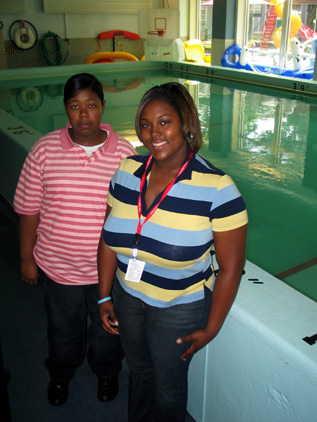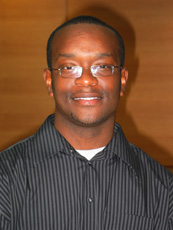 |
Jamecia Jones, right, and Marchetta Johnson, at the Munroe-Meyer Institute swimming pool during their 2005 summer internship, in which they spent two weeks working at MMI’s Camp Munroe. |
Both universities have sent graduates to UNMC, but Dillard is particularly close to UNMC because it was the first African American university to join UNMC in a formal affiliation partnership. Dillard has sent from five to 10 research interns every summer since 2003. Four Dillard students started UNMC this fall — Marcus Harris (College of Medicine), Renee Jackson and Kim Bernard (College of Pharmacy) and Davette Johnson (College of Dentistry).
Almost a week after Hurricane Katrina, there was still six feet of water in Xavier’s campus library. More than 460 Xavier students were initially trapped for several days on the upper floors of their dormitories by the floodwaters. Eventually, a relief caravan of 11 buses was sent to rescue the trapped students, administrators and family members and take them to Baton Rouge.
Three miles from Xavier, the Dillard campus fared even worse. The entire campus was inundated with eight feet of water for more than two weeks. Here’s what Dillard looked like, according to New York Times reporter Peter Applebome in a Sept. 25 article:
“There is piles of rubble at Dillard University where three modular student dorms used to be before a post-hurricane fire burned them to the ground. There is a soggy morass of ruined books and backpacks and notebooks in the student bookstore, a ghostly vista of shrubs turned black by the polluted water that covered the campus for two weeks, and no students.”
In addition to damaged schools, many of the black college students in New Orleans also have seen their family homes and parents’ incomes perish in the flood.
Dillard, fortunately, has just signed a Memorandum of Understanding with Tulane University to commence classes again in January using Tulane’s facilities. Dillard students, faculty and administrators will have ample classrooms, laboratories, auditoriums and administrative space on Tulane’s campus. Dillard will be able to maintain the identity and legacy it has earned during 135 years in New Orleans.
Xavier is still planning on reopening its campus in January 2006. Although it was severely flooded, the structure of most of its campus buildings and the general landscape will enable a faster recovery process.
LaKisha Williams, M.D., graduated from Xavier in 1998 and received her medical degree from UNMC in 2003. She currently is a third-year resident in psychiatry at Louisiana State University. She was living in New Orleans and doing an extended rotation in psychiatric services at Charity Hospital, the most heavily impacted hospital in New Orleans during and after the hurricane.
“I was evacuated out of New Orleans the day before the storm,” Dr. Williams said. “My fellow residents told me things got pretty rough in the hospital. I relocated to Memphis, Tenn., where I stayed for two weeks.
“I returned to New Orleans and found that my old apartment building had been surrounded by 7 feet of water. Although my apartment was elevated, it basically was still only about two feet above sea level. There was a five-foot high water mark in my living room. All the furniture had floated around and after two weeks of standing water, the entire place was mildewed and the smell was horrendous. In fact, I quickly realized that I should have entered my apartment wearing gloves, mask and protective clothing.
“I could only salvage a photograph of me at age 2 sitting on my mom’s lap. Everything else I owned – furniture, clothes, personal items, appliances – was lost. Yet, at least I was able to return and see it all for myself and get some closure. So many thousands of others still haven’t had even this opportunity.”
Dr. Williams is now providing psychiatric services to disaster relief centers in Baton Rouge and surrounding areas. It has been an adjustment she never imagined having to make.
“I had set my sights on living in New Orleans for the rest of my life,” Dr. Williams said. “It saddens me to think of what the city had to go through and will have to go through for months and years to come. I have pictures of my apartment and the devastation around the city. New Orleans is a ghost town now.”
Xavier President Norman C. Francis, Ph.D., estimates it will take $70 million to $90 million in aid to get back what Xavier lost. Dillard is facing an even more daunting future. Neither Xavier nor Dillard could afford business interruption insurance and although both have endowments of approximately $50 million, almost all of it is restricted to designated purposes.
But those are just the institutional losses and challenges. For the students, things were a lot more up front and personal. There were as many as 100,000 college students in New Orleans when the hurricane hit, including more than 6,000 students attending Xavier and Dillard.
“Most of the Dillard students lost everything,” said Jamecia Jones, a sophomore at Dillard who served a six-week internship with UNMC’s Physical Therapy Education last summer.
“Although we evacuated right away, we only took a few things with us in light bags because we assumed we’d only be gone a few days,” she said. “The flood took all of my personal possessions, from photos, computer, and records and tapes, to all of my clothes. I also lost more than $400 worth of schoolbooks. I had just moved into a new campus apartment. So I had a microwave, television, DVD/VHS player – a home away from home. Eight feet of standing flood water for more than two weeks ruined everything I owned.”
After returning to her parents’ home in Lake Charles, La., Jones began helping at two local shelters for other evacuees. That experience really helped to put her losses into perspective.
“I distributed personal items and toiletries, served meals and helped with the hundreds of children who had lost their homes,” Jones said. “Many of the people I assisted had been stuck at the Superdome and were still under a lot of shock and stress. A number of people died at the shelters during my first week back. They were already sick or aged and the traumas they suffered were too much.
“Working in the shelters helped me be really thankful that I made it out of New Orleans alive. What I lost was nothing compared to what thousands of others lost.”
Jones is currently taking some classes at McKeese State College in Lake Charles. She hopes to return to Dillard if the school reopens and says it’s stressful not knowing if she should wait for Dillard, or transfer permanently. She doesn’t know yet if the Tulane option is going to provide all the classes she needs to stay on track.
 |
Marcus Harris |
“A number of my friends from Dillard lost their cars to the flood, and some lost all their personal possessions,” Harris said. “I had a friend living on the third floor of an apartment building, and even he took on enough water to ruin even his place. I picture his apartment building and just can’t imagine water being up that high.
“Some Dillard students also suffered a second tragedy when the bus that was evacuating caught fire and destroyed all the stuff they were able to bring away from New Orleans. This has been just a very bad situation all the way around for Dillard. My alma mater is going to need a lot of help to get back on its feet.”
There have been many institutions that reached out to help the black students and are continuing to do so. A number of fellow member schools in the United Negro College Fund have opened their campuses to Dillard and Xavier students. For example, Alcorn State University and Hampton University have offered enrollment to any nursing and pharmacy students from either Xavier or Dillard.
Many predominately Caucasian institutions also have reached out to the students. UNMC extended its hand to all of the graduate students from New Orleans. Macalester College in St. Paul, Minn., offered free tuition, room and board to 60 Dillard students for the fall semester. Centenary College in Shreveport, La. – Dillard’s sister institution affiliated with the United Methodist Church – took in more than 275 Dillard students. It was during the six-bus caravan from Dillard to Centenary that one of the buses caught fire.
The United Negro College Fund has set up a special relief fund to benefit Xavier and Dillard Universities. The National Association for Equal Opportunity in Higher Education is coordinating with other universities to provide alternatives in the event that the historically black colleges and universities are not able to reopen and return to a regular academic schedule.
“New Orleans has played a major role in producing African American college graduates,” said Michael Lomax, Ph.D., president and chief executive of the United Negro College Fund, and president of Dillard University from 1997 to 2004. Dr. Lomax visited UNMC’s campus in 2002 for the historic signing of the affiliation agreement between UNMC and Dillard.
“Dillard was ranked 14th on the U.S. News and World Report’s list of comprehensive colleges and Xavier is the premier university of African Americans who go on and get their medical degrees. New Orleans has lost so much of its infrastructure; it can’t afford to lose its educational infrastructure as well. This is a case where the black colleges cannot be forgotten.”